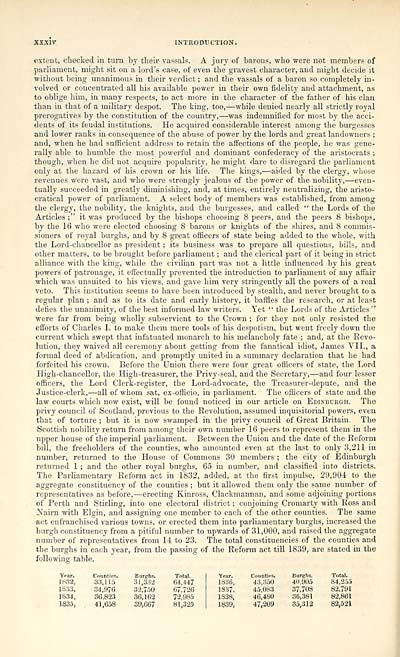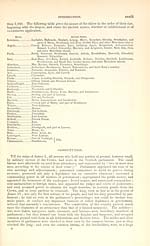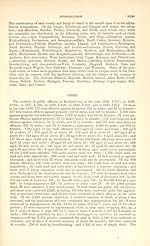Topographical, statistical, and historical gazetteer of Scotland > Volume 1
(46) Page xxxiv
Download files
Complete book:
Individual page:
Thumbnail gallery: Grid view | List view

xxxiv
INTRODUCTION.
extent, checked in turn by their vassals. A jury of barons, who were not members of
parliament, might sit on a lord's case, of even the gravest character, and might decide it
without being unanimous in their verdict ; and the vassals of a baron so completely in-
volved or concentrated all his available power in their own fidelity and attachment, as
to oblige him, in many respects, to act more in the character of the father of his clan
than in that of a military despot. The king, too, — while denied nearly all strictly royal
prerogatives by the constitution of the country, — was indemnified for most by the acci-
dents of its feudal institutions. He acquired considerable interest among the burgesses
and lower ranks in consequence of the abuse of power by the lords and great landowners ;
and, when he had sufficient address to retain the affections of the people, he was gene-
rally able to humble the most powerful and dominant confederacy of the aristocrats ;
though, when he did not acquire popularity, he might dare to disregard the parliament
only at the hazard of his crown or his life. The kings, — aided by the clergy, whose
revenues were vast, and who were strongly jealous of the power of the nobility, — even-
tually succeeded in greatly diminishing, and, at times, entirely neutralizing-, the aristo-
cratical power of parliament. A select body of members was established, from among
the clergy, the nobility, the knights, and the burgesses, and called " the Lords of the
Articles ;" it was produced by the bishops choosing 8 peers, and the peers 8 bishops,
by the 16 who were elected choosing 8 barons or knights of the shires, and 8 commis-
sioners of royal burghs, and by 8 great officers of state being added to the whole, with
the Lord-chancellor as president ; its business was to prepare all questions, bills, and
other matters, to be brought before parliament ; and the clerical part of it being in strict
alliance with the king, while the civilian part was not a little influenced by his great
powers of patronage, it effectually prevented the introduction to parliament of any affair
which was unsuited to his views, and gave him very stringently all the powers of a real
veto. This institution seems to have been introduced by stealth, and never brought to a
regular plan ; and as to its date and early history, it baffles the research, or at least
defies the unanimity, of the best informed law writers. Yet " the Lords of the Articles "
were far from being wholly subservient to the Crown ; for they not only resisted the
efforts of Charles I. to make them mere tools of his despotism, but went freely down the
current which swept that infatuated monarch to his melancholy fate ; and, at the Revo-
lution, they waived all ceremony about getting from the fanatical idiot, James VII., a
formal deed of abdication, and promptly united in a summary declaration that he had
forfeited his crown. Before the Union there were four great officers of state, the Lord
High-chancellor, the High-treasurer, the Privy-seal, and the Secretary, — and four lesser
officers, the Lord Clerk-register, the Lord-advocate, the Treasurer-depute, and the
Justice-clerk, — all of whom sat, ex-officio, in parliament. The officers of state and the
law courts which now exist, will be found noticed in our article on Edinburgh. The
privy council of Scotland, previous to the Revolution, assumed inquisitorial powers, even
that of torture ; but it is now swamped in the privy council of Great Britain. Tho
Scottish nobility return from among their own number 16 peers to represent them in the
tipper house of the imperial parliament. Between the Union and the date of the Reform
bill, the freeholders of the counties, who amounted even at the last to only 3,211 in
number, returned to the House of Commons 30 members ; the city of Edinburgh
returned 1 ; and the other royal burghs, 6-5 in number, and classified into districts.
The Parliamentary Reform act in 1832, added, at the first impulse, 29,904 to the
aggregate constituency of the counties ; but it allowed them only the same number of
representatives as before, — erecting Kinross, Clackmannan, and some adjoining portions
of Perth and Stirling, into one electoral district ; conjoining Cromarty with Ross and
Nairn with Elgin, and assigning one member to each of the other counties. The same
act enfranchised various towns, or erected them into parliamentary burghs, increased the
burgh constituency from a pitiful number to upwards of 31,000, and raised the aggregate
number of representatives from 14 to 23. The total constituencies of the counties and
the burghs in each year, from the passing of the Reform act till 1839, are stated in the
following table.
Year.
Counties.
Burphs.
Total.
Year.
Counties.
Burghs.
Total.
1832,
33,115
3 1 ,332
64,447
1836,
43,350
40,905
84,255
1833,
34,976
32,750
67,726
18.37,
45,083
37,708
82,791
18.34,
36,823
36,162
72,985
1838,
46,480
36,381
82,861
1835,
41,658
39,667
81,325
1839,
47,209
35,312
82,521
INTRODUCTION.
extent, checked in turn by their vassals. A jury of barons, who were not members of
parliament, might sit on a lord's case, of even the gravest character, and might decide it
without being unanimous in their verdict ; and the vassals of a baron so completely in-
volved or concentrated all his available power in their own fidelity and attachment, as
to oblige him, in many respects, to act more in the character of the father of his clan
than in that of a military despot. The king, too, — while denied nearly all strictly royal
prerogatives by the constitution of the country, — was indemnified for most by the acci-
dents of its feudal institutions. He acquired considerable interest among the burgesses
and lower ranks in consequence of the abuse of power by the lords and great landowners ;
and, when he had sufficient address to retain the affections of the people, he was gene-
rally able to humble the most powerful and dominant confederacy of the aristocrats ;
though, when he did not acquire popularity, he might dare to disregard the parliament
only at the hazard of his crown or his life. The kings, — aided by the clergy, whose
revenues were vast, and who were strongly jealous of the power of the nobility, — even-
tually succeeded in greatly diminishing, and, at times, entirely neutralizing-, the aristo-
cratical power of parliament. A select body of members was established, from among
the clergy, the nobility, the knights, and the burgesses, and called " the Lords of the
Articles ;" it was produced by the bishops choosing 8 peers, and the peers 8 bishops,
by the 16 who were elected choosing 8 barons or knights of the shires, and 8 commis-
sioners of royal burghs, and by 8 great officers of state being added to the whole, with
the Lord-chancellor as president ; its business was to prepare all questions, bills, and
other matters, to be brought before parliament ; and the clerical part of it being in strict
alliance with the king, while the civilian part was not a little influenced by his great
powers of patronage, it effectually prevented the introduction to parliament of any affair
which was unsuited to his views, and gave him very stringently all the powers of a real
veto. This institution seems to have been introduced by stealth, and never brought to a
regular plan ; and as to its date and early history, it baffles the research, or at least
defies the unanimity, of the best informed law writers. Yet " the Lords of the Articles "
were far from being wholly subservient to the Crown ; for they not only resisted the
efforts of Charles I. to make them mere tools of his despotism, but went freely down the
current which swept that infatuated monarch to his melancholy fate ; and, at the Revo-
lution, they waived all ceremony about getting from the fanatical idiot, James VII., a
formal deed of abdication, and promptly united in a summary declaration that he had
forfeited his crown. Before the Union there were four great officers of state, the Lord
High-chancellor, the High-treasurer, the Privy-seal, and the Secretary, — and four lesser
officers, the Lord Clerk-register, the Lord-advocate, the Treasurer-depute, and the
Justice-clerk, — all of whom sat, ex-officio, in parliament. The officers of state and the
law courts which now exist, will be found noticed in our article on Edinburgh. The
privy council of Scotland, previous to the Revolution, assumed inquisitorial powers, even
that of torture ; but it is now swamped in the privy council of Great Britain. Tho
Scottish nobility return from among their own number 16 peers to represent them in the
tipper house of the imperial parliament. Between the Union and the date of the Reform
bill, the freeholders of the counties, who amounted even at the last to only 3,211 in
number, returned to the House of Commons 30 members ; the city of Edinburgh
returned 1 ; and the other royal burghs, 6-5 in number, and classified into districts.
The Parliamentary Reform act in 1832, added, at the first impulse, 29,904 to the
aggregate constituency of the counties ; but it allowed them only the same number of
representatives as before, — erecting Kinross, Clackmannan, and some adjoining portions
of Perth and Stirling, into one electoral district ; conjoining Cromarty with Ross and
Nairn with Elgin, and assigning one member to each of the other counties. The same
act enfranchised various towns, or erected them into parliamentary burghs, increased the
burgh constituency from a pitiful number to upwards of 31,000, and raised the aggregate
number of representatives from 14 to 23. The total constituencies of the counties and
the burghs in each year, from the passing of the Reform act till 1839, are stated in the
following table.
Year.
Counties.
Burphs.
Total.
Year.
Counties.
Burghs.
Total.
1832,
33,115
3 1 ,332
64,447
1836,
43,350
40,905
84,255
1833,
34,976
32,750
67,726
18.37,
45,083
37,708
82,791
18.34,
36,823
36,162
72,985
1838,
46,480
36,381
82,861
1835,
41,658
39,667
81,325
1839,
47,209
35,312
82,521
Set display mode to: Large image | Transcription
Images and transcriptions on this page, including medium image downloads, may be used under the Creative Commons Attribution 4.0 International Licence unless otherwise stated. ![]()
| Gazetteers of Scotland, 1803-1901 > Topographical, statistical, and historical gazetteer of Scotland > Volume 1 > (46) Page xxxiv |
|---|
| Permanent URL | https://digital.nls.uk/97438098 |
|---|
| Description | Volume first. A-H. |
|---|---|
| Attribution and copyright: |
|

